人教版(2019) 必修 第二册 Unit 4 History and traditions Reading and Thinking 课件 (34张)
文档属性
| 名称 | 人教版(2019) 必修 第二册 Unit 4 History and traditions Reading and Thinking 课件 (34张) | 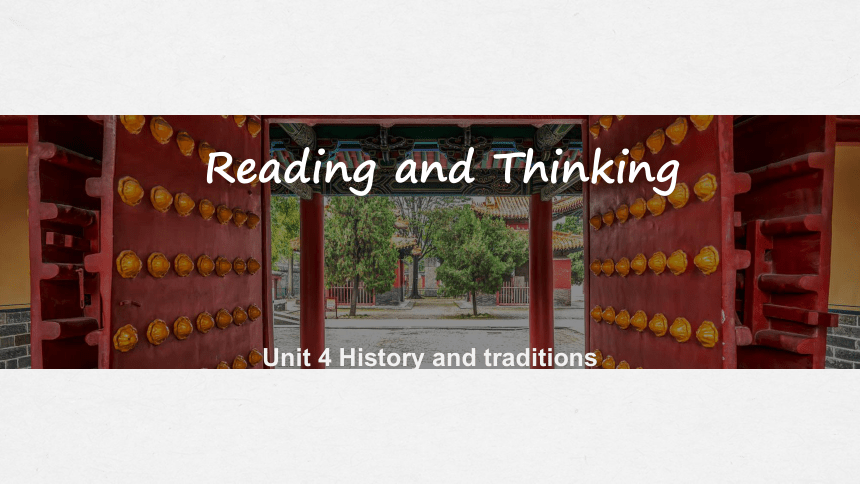 | |
| 格式 | pptx | ||
| 文件大小 | 93.6MB | ||
| 资源类型 | 教案 | ||
| 版本资源 | 人教版(2019) | ||
| 科目 | 英语 | ||
| 更新时间 | 2024-04-04 23:00:26 | ||
图片预览

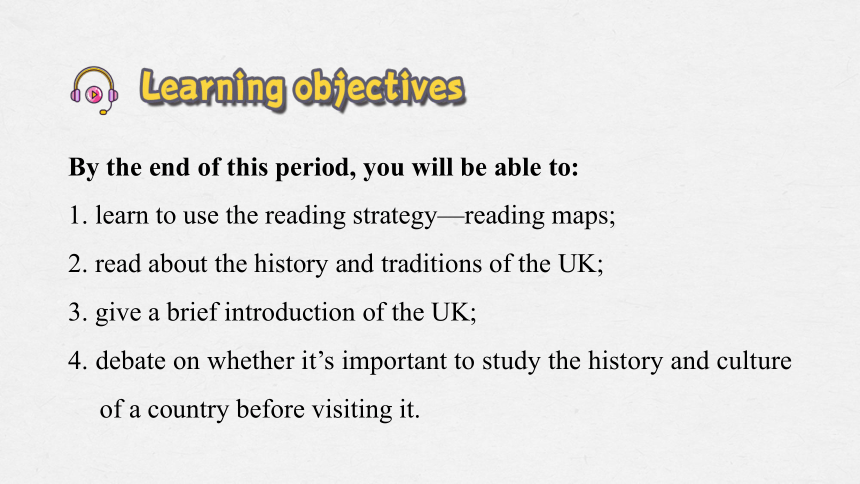

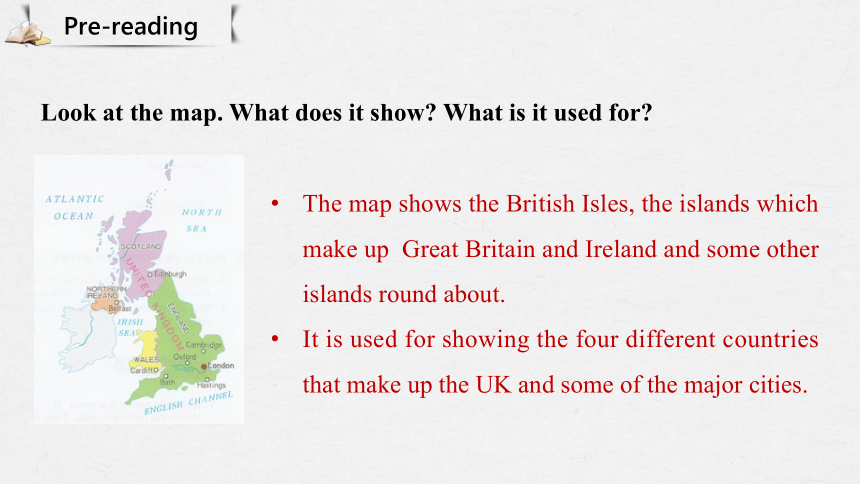
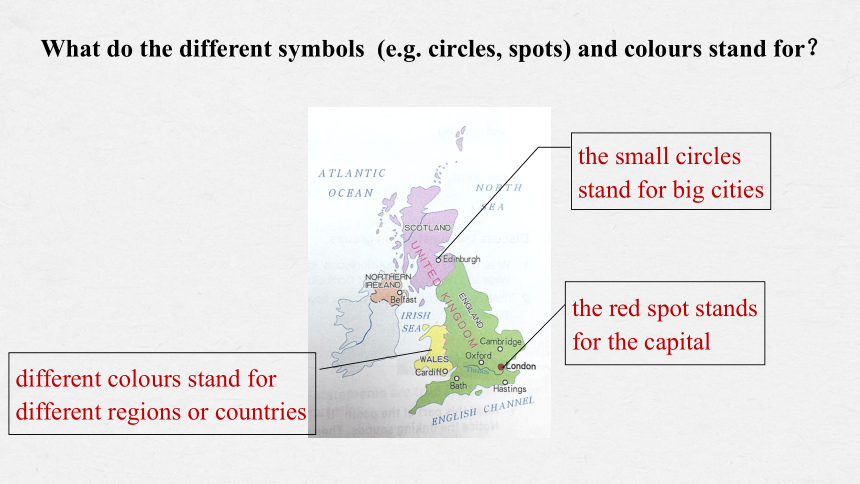
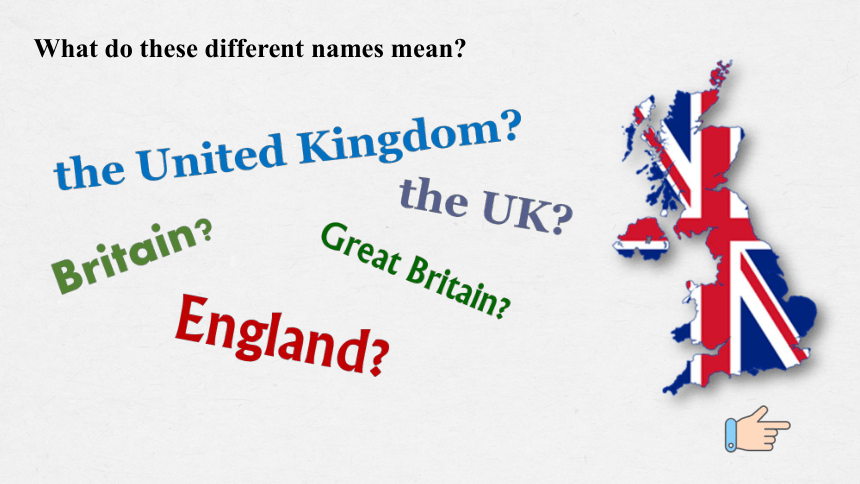
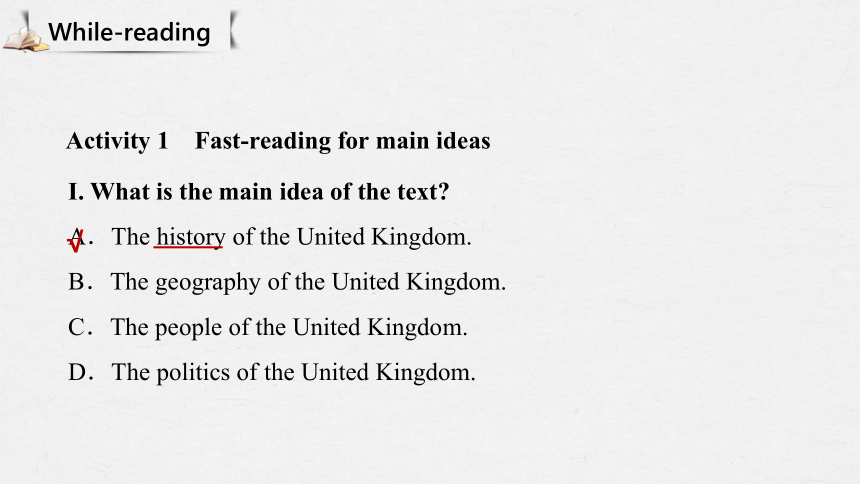
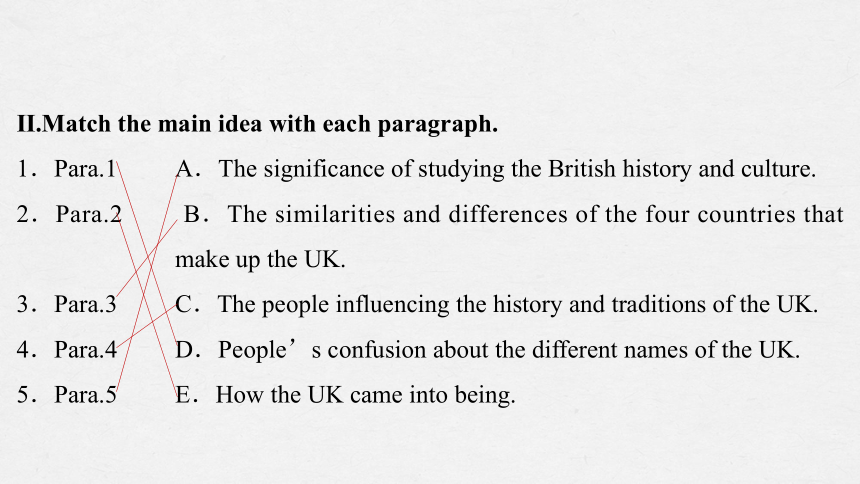
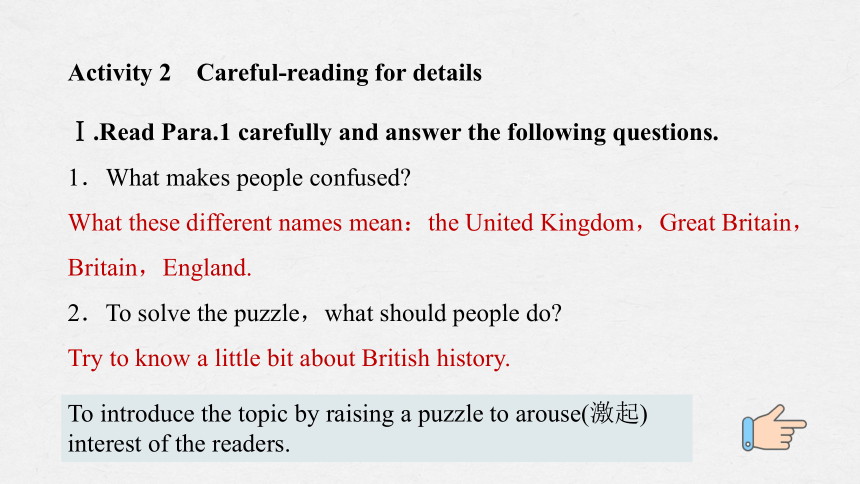
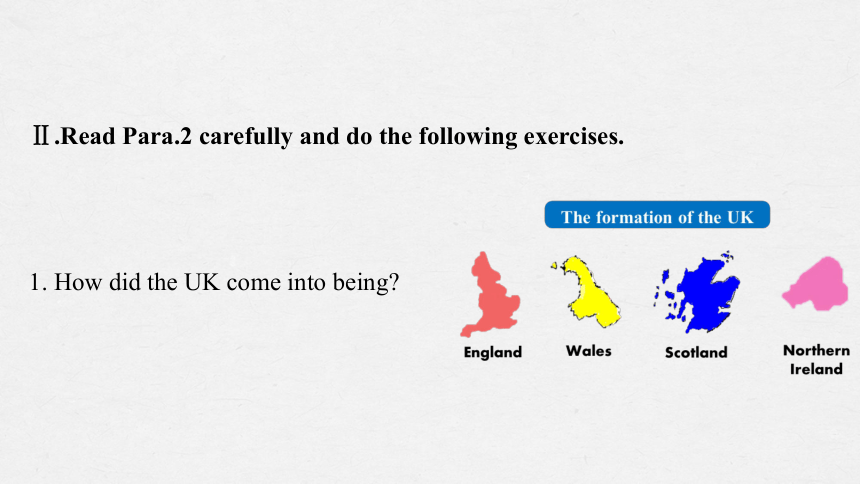
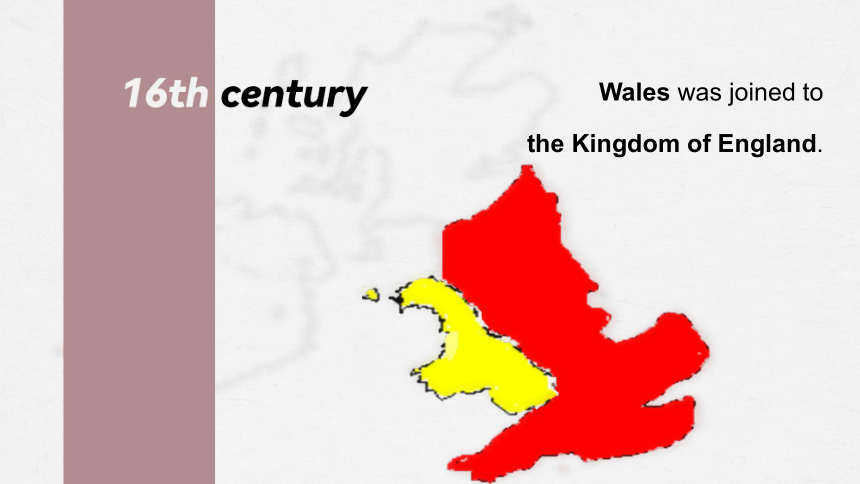
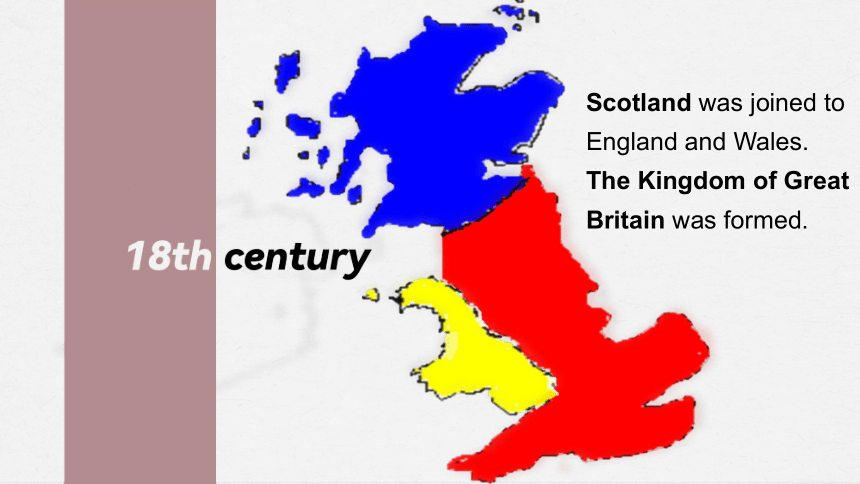
文档简介
(共34张PPT)
Unit 4 History and traditions
Reading and Thinking
By the end of this period, you will be able to:
1. learn to use the reading strategy—reading maps;
2. read about the history and traditions of the UK;
3. give a brief introduction of the UK;
4. debate on whether it’s important to study the history and culture of a country before visiting it.
A people without the knowledge of their past history, origin and culture is like a tree without roots.
—Marcus Garvey
Look at the map. What does it show What is it used for
The map shows the British Isles, the islands which make up Great Britain and Ireland and some other islands round about.
It is used for showing the four different countries that make up the UK and some of the major cities.
Pre-reading
the small circles stand for big cities
the red spot stands for the capital
different colours stand for different regions or countries
What do the different symbols (e.g. circles, spots) and colours stand for?
What do these different names mean
While-reading
Ⅰ. What is the main idea of the text
A.The history of the United Kingdom.
B.The geography of the United Kingdom.
C.The people of the United Kingdom.
D.The politics of the United Kingdom.
√
Activity 1 Fast-reading for main ideas
Ⅱ.Match the main idea with each paragraph.
1.Para.1 A.The significance of studying the British history and culture.
2.Para.2 B.The similarities and differences of the four countries that make up the UK.
3.Para.3 C.The people influencing the history and traditions of the UK.
4.Para.4 D.People’s confusion about the different names of the UK.
5.Para.5 E.How the UK came into being.
Activity 2 Careful-reading for details
Ⅰ.Read Para.1 carefully and answer the following questions.
1.What makes people confused
What these different names mean:the United Kingdom,Great Britain,Britain,England.
2.To solve the puzzle,what should people do
Try to know a little bit about British history.
To introduce the topic by raising a puzzle to arouse(激起) interest of the readers.
Ⅱ.Read Para.2 carefully and do the following exercises.
1. How did the UK come into being
Wales was joined to
the Kingdom of England.
Scotland was joined to England and Wales.
The Kingdom of Great Britain was formed.
The Kingdom of Ireland was added to the Kingdom of Great Britain.
The United Kingdom of Great Britain and Ireland was created.
The southern part of Ireland broke away from the UK.
The United Kingdom of Great Britain and Northern Ireland was formed.
The Kingdom of England
The Kingdom of Great Britain
The United Kingdom of Great Britain and Ireland
The United Kingdom of Great Britain and Northern Ireland/the United Kingdom/the UK
Retell the formation of the UK according to the maps.
2.When did the name “the United Kingdom of Great Britain and Northern Ireland” begin to appear
A.In the 16th century. B.In the 18th century.
C.In the 19th century. D.In the 20th century.
3.Which of the following is NOT part of the UK
A.England. B.Scotland.
C.Northern Ireland. D.Southern Ireland.
√
√
4. What name do most people use nowadays to refer to the United Kingdom of Great Britain and Northern Ireland
Most people just use the shortened name: “the United Kingdom” or “the UK”.
5. What are people from the UK called
People from the UK are called British.
Do the four countries work together in all areas
Ⅲ.Read Para.3 carefully and do the following exercises.
1. List the similarities and differences among the four countries.
Similarities _____; _________; ________________
Differences ___________ and _____ systems; __________________ and even ______________ for competitions
currency
flag
military defence
educational
legal
their own traditions
football teams
2.How does the writer develop this paragraph
A.By expressing some personal opinions.
B.By using a couple of quotes.
C.By referring to a social phenomenon.
D.By making some comparisons.
√
Ⅳ. Read Para.4 carefully and do the following exercises.
1. List the people influencing the history and their influence to the UK.
towns and roads
the beginning of the English language; the way to build houses
vocabulary and
names of locations
castles, legal system, and new words from French
the Vikings
the Romans
the Normans
the Anglo-Saxons
2.Which invaders influenced the UK’s language most
A.The Anglo-Saxons. B.The Romans.
C.The Normans. D.The Vikings.
3.Which group of people made changes to the legal system of the UK
A.The Romans. B.The Vikings.
C.The Normans. D.The Anglo-Saxons.
√
√
Watch the video and discuss:
What changes did these historic events bring to English language
Ⅴ.Read Para.5 carefully and do the following exercises.
1.What’s the writer’s attitude towards studying the history
A.Neutral. B.Indifferent.
C.Favorable. D.Doubtful.
2.Who might be the target reader of this passage
A.Teachers. B.Students.
C.Tourists. D.Guides.
√
√
plete the conversation about the UK using the phrases in their correct forms.
A: I can never remember what the UK means! There's England, Britain, __________ Great Britain!
B: Well, it helps if you remember that there are four countries that the UK. That's why it's called the United Kingdom.
A: Four countries I must have been asleep in that part of our history class! So the first country was England, and the others were that
B: Yes, right. First England, then Wales, then Scotland. The last country was Ireland, but later the southern half didn't want to be the United Kingdom.
A: Oh, I remember now! The southern part from Northern Ireland, right
B: Yes, you got it well remembered! but in history class next time.
as well as belong to add to join to break away keep your eyes open
as well as
belong to
added to
joined to
broke away
keep your eyes open
it is helpful...
get+o+c
Post-reading
Activity 1 Discussion
1.Imagine you are a tour guide for visitors to the UK,make a brief introduction of British history in four parts: history of four groups of ruling people;history of how the UK gets its full name; the similarities and differences between four countries nowadays;the significance of studying the British history.(Creative thinking)
2.Why is it important to study the history and culture of a country before visiting it (Critical thinking)
Because it will help you understand the place better and you will have a more enjoyable experience.And you will be able to interact better with the people...
Activity 2 Summary
Read the passage again and fill in the blanks.
The United Kingdom,Great Britain,Britain,England—many people are confused by 1.____ these different names mean.In the 16th century,the nearby country of Wales 2.__________(join) to the Kingdom of England.In the 19th century,the Kingdom of Ireland was added to create the United Kingdom of Great Britain and Ireland.Finally,the southern part of Ireland 3._____(break) away from the UK,which resulted in the full name we have today.However,most people just use the 4._________(shorten) name: the UK.The four countries 5.__________ belong to the United Kingdom work together in some areas.
what
was joined
broke
shortened
that/which
There were four sets of invaders and the last group were the Normans. They had castles 6._____(build) all around England and made changes 7.__ the legal system. Studying the history of the country will make your visit much 8.______________(enjoy).The capital city London is 9.__ ancient port city that has a history 10.______(date) back to Roman times.
built
to
more enjoyable
an
dating
Sentences Analysis
1.They use the same flag,known as the Union Jack,as well as share the same currency and military defence.
[句式分析] 此句是____句。known as意思是“______________”,为过去分词短语作________,修饰flag,若变成定语从句应在前面加________________。
[自主翻译]
简单
作为……而闻名
后置定语
which is
像拥有同样的货币和国防一样,他们也使用同一面被称为“Union Jack”的国旗。
2.The United Kingdom has a long and interesting history to explore,which can help you understand much more about the country and its traditions.
[句式分析] 此句是____句。to explore是不定式作________;关系代词which引导____________从句,修饰history。
[自主翻译]
复合
后置定语
非限制性定语
英国历史源远流长、别有趣味,等待你去探索,帮助你更加深入地了解这一国家及其传统。
3.Almost everywhere you go in the UK,you will be surrounded by evidence of four different groups of people who took over at different times throughout history.
[句式分析] 此句是____句。Almost everywhere you go in the UK 是________从句,相当于__________ you go in the UK 或_______________ you go in the UK;who引导______ 从句,在从句中作____ 语;短语took over意思是“_______”。
[自主翻译]
复合
让步状语
wherever
no matter where
定语
主
接管
英国历史上有四个不同民族在不同历史时期执掌这个国家。无论你身处英国何方,这些民族的遗迹都随处可见。
4.The capital city London is a great place to start,as it is an ancient port city that has a history dating all the way back to Roman times.
[句式分析] 此句是____句。to start是不定式作________;as引导________从句;that引导____从句,在从句中作主语,指代port city;后面的dating all the way back to“追溯到”,为现在分词短语作________。
[自主翻译]
复合
后置定语
原因状语
定语
后置定语
以首都伦敦为第一站是个不错的选择,因为伦敦是一个古老的港口城市,其历史可以追溯到罗马时代。
5.If you keep your eyes open,you will be surprised to find that you can see both its past and its present.
[句式分析] 此句是____句。if引导________从句,体现“________”的原则;that引导____从句。
[自主翻译]
复合
条件状语
主将从现
宾语
如果用心去观察,英国的过去和现在都将展示在你的面前,令你叹为观止。
Homework
Review what we have learnt and preview language points.
Unit 4 History and traditions
Reading and Thinking
By the end of this period, you will be able to:
1. learn to use the reading strategy—reading maps;
2. read about the history and traditions of the UK;
3. give a brief introduction of the UK;
4. debate on whether it’s important to study the history and culture of a country before visiting it.
A people without the knowledge of their past history, origin and culture is like a tree without roots.
—Marcus Garvey
Look at the map. What does it show What is it used for
The map shows the British Isles, the islands which make up Great Britain and Ireland and some other islands round about.
It is used for showing the four different countries that make up the UK and some of the major cities.
Pre-reading
the small circles stand for big cities
the red spot stands for the capital
different colours stand for different regions or countries
What do the different symbols (e.g. circles, spots) and colours stand for?
What do these different names mean
While-reading
Ⅰ. What is the main idea of the text
A.The history of the United Kingdom.
B.The geography of the United Kingdom.
C.The people of the United Kingdom.
D.The politics of the United Kingdom.
√
Activity 1 Fast-reading for main ideas
Ⅱ.Match the main idea with each paragraph.
1.Para.1 A.The significance of studying the British history and culture.
2.Para.2 B.The similarities and differences of the four countries that make up the UK.
3.Para.3 C.The people influencing the history and traditions of the UK.
4.Para.4 D.People’s confusion about the different names of the UK.
5.Para.5 E.How the UK came into being.
Activity 2 Careful-reading for details
Ⅰ.Read Para.1 carefully and answer the following questions.
1.What makes people confused
What these different names mean:the United Kingdom,Great Britain,Britain,England.
2.To solve the puzzle,what should people do
Try to know a little bit about British history.
To introduce the topic by raising a puzzle to arouse(激起) interest of the readers.
Ⅱ.Read Para.2 carefully and do the following exercises.
1. How did the UK come into being
Wales was joined to
the Kingdom of England.
Scotland was joined to England and Wales.
The Kingdom of Great Britain was formed.
The Kingdom of Ireland was added to the Kingdom of Great Britain.
The United Kingdom of Great Britain and Ireland was created.
The southern part of Ireland broke away from the UK.
The United Kingdom of Great Britain and Northern Ireland was formed.
The Kingdom of England
The Kingdom of Great Britain
The United Kingdom of Great Britain and Ireland
The United Kingdom of Great Britain and Northern Ireland/the United Kingdom/the UK
Retell the formation of the UK according to the maps.
2.When did the name “the United Kingdom of Great Britain and Northern Ireland” begin to appear
A.In the 16th century. B.In the 18th century.
C.In the 19th century. D.In the 20th century.
3.Which of the following is NOT part of the UK
A.England. B.Scotland.
C.Northern Ireland. D.Southern Ireland.
√
√
4. What name do most people use nowadays to refer to the United Kingdom of Great Britain and Northern Ireland
Most people just use the shortened name: “the United Kingdom” or “the UK”.
5. What are people from the UK called
People from the UK are called British.
Do the four countries work together in all areas
Ⅲ.Read Para.3 carefully and do the following exercises.
1. List the similarities and differences among the four countries.
Similarities _____; _________; ________________
Differences ___________ and _____ systems; __________________ and even ______________ for competitions
currency
flag
military defence
educational
legal
their own traditions
football teams
2.How does the writer develop this paragraph
A.By expressing some personal opinions.
B.By using a couple of quotes.
C.By referring to a social phenomenon.
D.By making some comparisons.
√
Ⅳ. Read Para.4 carefully and do the following exercises.
1. List the people influencing the history and their influence to the UK.
towns and roads
the beginning of the English language; the way to build houses
vocabulary and
names of locations
castles, legal system, and new words from French
the Vikings
the Romans
the Normans
the Anglo-Saxons
2.Which invaders influenced the UK’s language most
A.The Anglo-Saxons. B.The Romans.
C.The Normans. D.The Vikings.
3.Which group of people made changes to the legal system of the UK
A.The Romans. B.The Vikings.
C.The Normans. D.The Anglo-Saxons.
√
√
Watch the video and discuss:
What changes did these historic events bring to English language
Ⅴ.Read Para.5 carefully and do the following exercises.
1.What’s the writer’s attitude towards studying the history
A.Neutral. B.Indifferent.
C.Favorable. D.Doubtful.
2.Who might be the target reader of this passage
A.Teachers. B.Students.
C.Tourists. D.Guides.
√
√
plete the conversation about the UK using the phrases in their correct forms.
A: I can never remember what the UK means! There's England, Britain, __________ Great Britain!
B: Well, it helps if you remember that there are four countries that the UK. That's why it's called the United Kingdom.
A: Four countries I must have been asleep in that part of our history class! So the first country was England, and the others were that
B: Yes, right. First England, then Wales, then Scotland. The last country was Ireland, but later the southern half didn't want to be the United Kingdom.
A: Oh, I remember now! The southern part from Northern Ireland, right
B: Yes, you got it well remembered! but in history class next time.
as well as belong to add to join to break away keep your eyes open
as well as
belong to
added to
joined to
broke away
keep your eyes open
it is helpful...
get+o+c
Post-reading
Activity 1 Discussion
1.Imagine you are a tour guide for visitors to the UK,make a brief introduction of British history in four parts: history of four groups of ruling people;history of how the UK gets its full name; the similarities and differences between four countries nowadays;the significance of studying the British history.(Creative thinking)
2.Why is it important to study the history and culture of a country before visiting it (Critical thinking)
Because it will help you understand the place better and you will have a more enjoyable experience.And you will be able to interact better with the people...
Activity 2 Summary
Read the passage again and fill in the blanks.
The United Kingdom,Great Britain,Britain,England—many people are confused by 1.____ these different names mean.In the 16th century,the nearby country of Wales 2.__________(join) to the Kingdom of England.In the 19th century,the Kingdom of Ireland was added to create the United Kingdom of Great Britain and Ireland.Finally,the southern part of Ireland 3._____(break) away from the UK,which resulted in the full name we have today.However,most people just use the 4._________(shorten) name: the UK.The four countries 5.__________ belong to the United Kingdom work together in some areas.
what
was joined
broke
shortened
that/which
There were four sets of invaders and the last group were the Normans. They had castles 6._____(build) all around England and made changes 7.__ the legal system. Studying the history of the country will make your visit much 8.______________(enjoy).The capital city London is 9.__ ancient port city that has a history 10.______(date) back to Roman times.
built
to
more enjoyable
an
dating
Sentences Analysis
1.They use the same flag,known as the Union Jack,as well as share the same currency and military defence.
[句式分析] 此句是____句。known as意思是“______________”,为过去分词短语作________,修饰flag,若变成定语从句应在前面加________________。
[自主翻译]
简单
作为……而闻名
后置定语
which is
像拥有同样的货币和国防一样,他们也使用同一面被称为“Union Jack”的国旗。
2.The United Kingdom has a long and interesting history to explore,which can help you understand much more about the country and its traditions.
[句式分析] 此句是____句。to explore是不定式作________;关系代词which引导____________从句,修饰history。
[自主翻译]
复合
后置定语
非限制性定语
英国历史源远流长、别有趣味,等待你去探索,帮助你更加深入地了解这一国家及其传统。
3.Almost everywhere you go in the UK,you will be surrounded by evidence of four different groups of people who took over at different times throughout history.
[句式分析] 此句是____句。Almost everywhere you go in the UK 是________从句,相当于__________ you go in the UK 或_______________ you go in the UK;who引导______ 从句,在从句中作____ 语;短语took over意思是“_______”。
[自主翻译]
复合
让步状语
wherever
no matter where
定语
主
接管
英国历史上有四个不同民族在不同历史时期执掌这个国家。无论你身处英国何方,这些民族的遗迹都随处可见。
4.The capital city London is a great place to start,as it is an ancient port city that has a history dating all the way back to Roman times.
[句式分析] 此句是____句。to start是不定式作________;as引导________从句;that引导____从句,在从句中作主语,指代port city;后面的dating all the way back to“追溯到”,为现在分词短语作________。
[自主翻译]
复合
后置定语
原因状语
定语
后置定语
以首都伦敦为第一站是个不错的选择,因为伦敦是一个古老的港口城市,其历史可以追溯到罗马时代。
5.If you keep your eyes open,you will be surprised to find that you can see both its past and its present.
[句式分析] 此句是____句。if引导________从句,体现“________”的原则;that引导____从句。
[自主翻译]
复合
条件状语
主将从现
宾语
如果用心去观察,英国的过去和现在都将展示在你的面前,令你叹为观止。
Homework
Review what we have learnt and preview language points.
